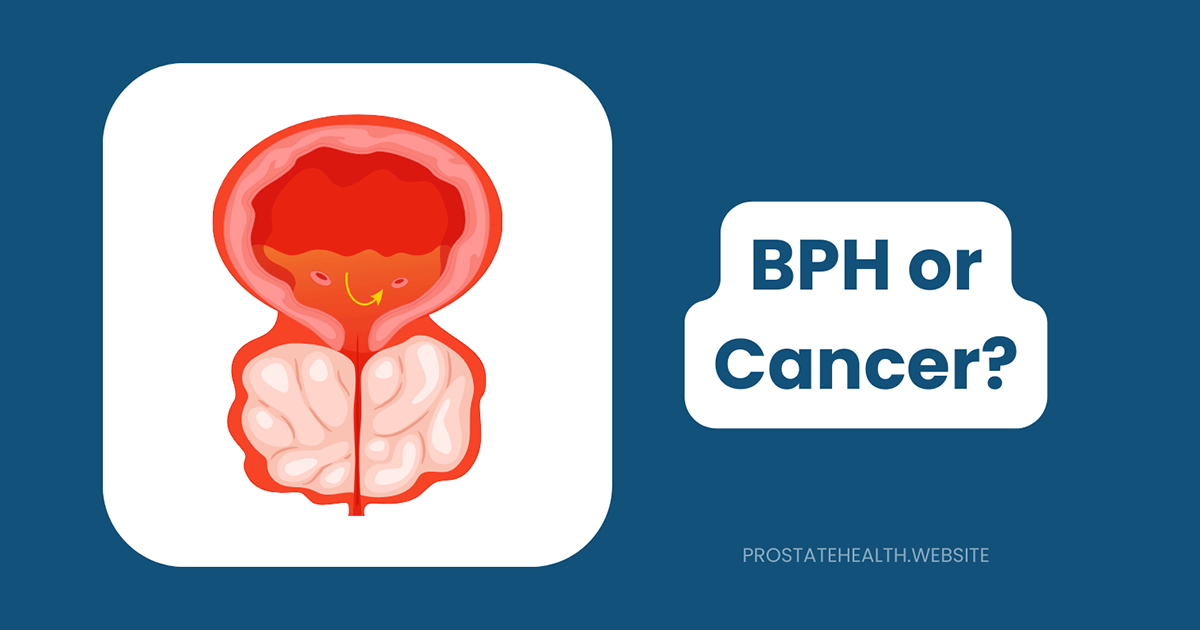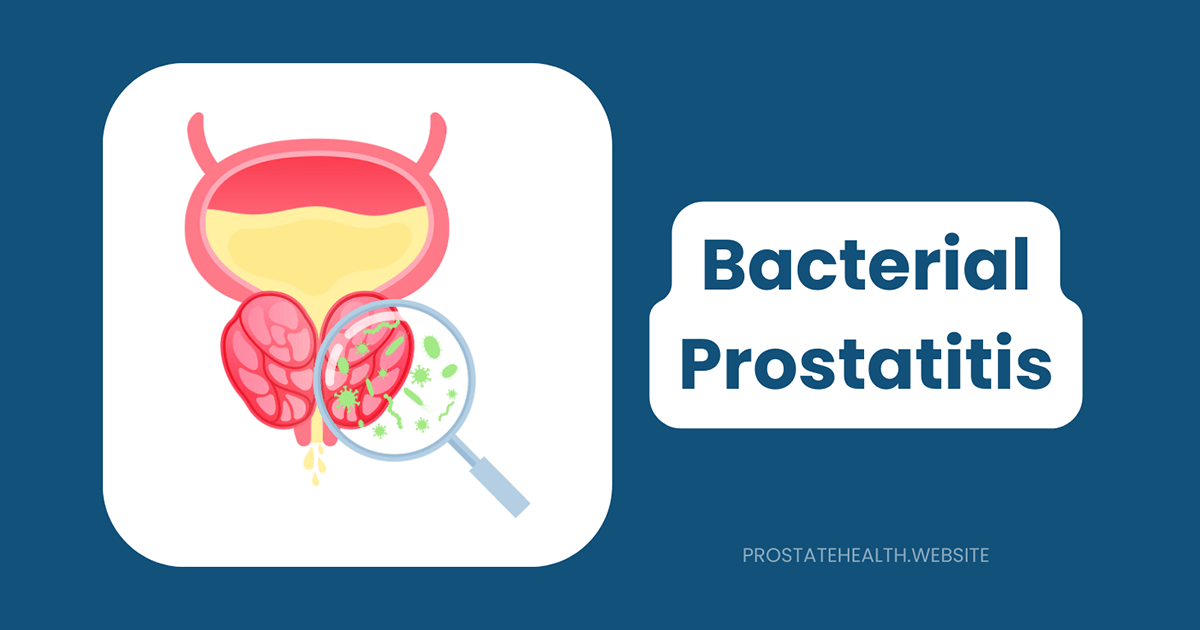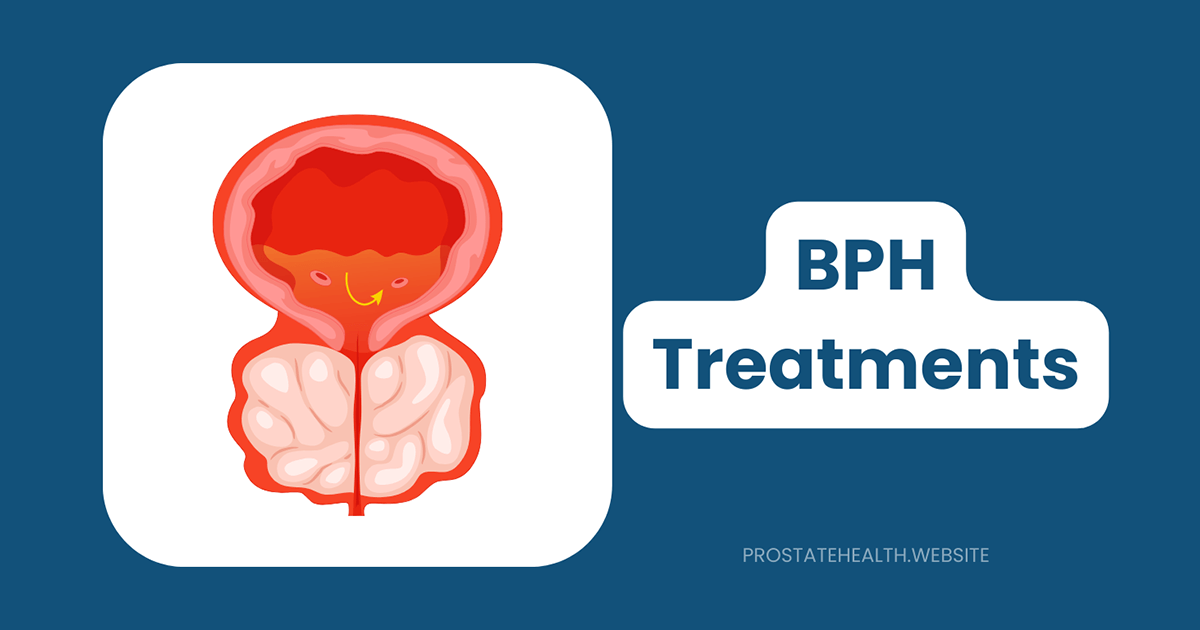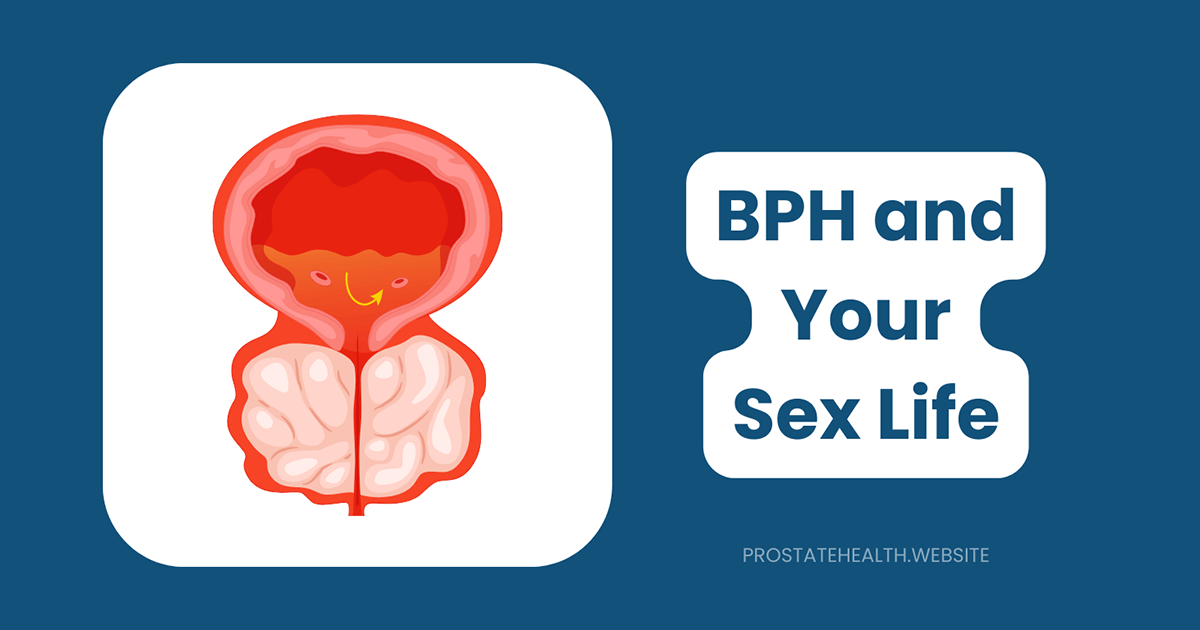BPH vs. Prostate Cancer: Understanding the Differences

When men experience urinary symptoms or learn about a rising PSA level, two conditions often come to mind: benign prostatic hyperplasia (BPH) and prostate cancer. While both affect the same gland and can share similar symptoms, they are fundamentally different conditions with distinct implications for health and treatment.
Throughout my years of advocating for men’s health, I’ve found that understanding the differences between BPH and prostate cancer can reduce anxiety, encourage appropriate medical care, and empower men to make informed decisions about their health. Let’s explore these two common prostate conditions and clarify what sets them apart.
The Basics: What Are BPH and Prostate Cancer?
Before diving into the differences, let’s establish a clear understanding of each condition:
Benign Prostatic Hyperplasia (BPH)
BPH is a non-cancerous enlargement of the prostate gland. The term “benign” is crucial here—it means the condition is not cancer and cannot spread to other parts of the body. “Hyperplasia” refers to an increase in the number of cells, leading to enlargement of the gland.
BPH is extremely common as men age. According to the American Urological Association, about 50% of men between ages 51 and 60 have BPH. This prevalence increases to approximately 70% for men in their 60s and reaches nearly 90% for men over 80.
Prostate Cancer
Prostate cancer occurs when cells in the prostate gland begin to grow uncontrollably. Unlike BPH, these are malignant (cancerous) cells that can potentially spread beyond the prostate to other parts of the body if left untreated.
Prostate cancer is also common, though less so than BPH. According to the American Cancer Society, about 1 in 8 men (12.5%) will be diagnosed with prostate cancer during their lifetime. It is the second most common cancer in American men, behind only skin cancer.
Key Differences: BPH vs. Prostate Cancer
Now let’s examine the fundamental differences between these two conditions:
1. Nature of the Condition
BPH:
- Non-cancerous (benign) growth
- Cannot spread to other parts of the body
- Natural part of aging for many men
- Involves growth of normal prostate cells
Prostate Cancer:
- Cancerous (malignant) growth
- Can potentially spread (metastasize) to other parts of the body
- Not a normal part of aging
- Involves abnormal, mutated cells
2. Location Within the Prostate
One of the most interesting differences between BPH and prostate cancer is where they typically develop within the prostate:
BPH:
- Primarily affects the transition zone of the prostate, which surrounds the urethra
- Grows inward, often compressing the urethra
- This explains why urinary symptoms are so common with BPH
Prostate Cancer:
- Most commonly begins in the peripheral zone of the prostate (about 70-80% of cases)
- This outer portion of the prostate is closest to the rectum
- This is why doctors can sometimes feel suspicious nodules during a digital rectal exam
- Less commonly, can develop in the transition zone (about 10-20% of cases) or central zone
3. Risk Factors
While some risk factors overlap, there are important differences:
BPH Risk Factors:
- Age (primary factor)
- Family history of BPH
- Obesity and sedentary lifestyle
- Diabetes and heart disease
- Erectile dysfunction
Prostate Cancer Risk Factors:
- Age (primary factor)
- Family history of prostate cancer
- Race (higher risk in African American men)
- Genetic mutations (BRCA1/2, Lynch syndrome)
- Diet high in red meat and high-fat dairy products
4. Symptoms
This is where confusion often arises, as both conditions can cause similar urinary symptoms:
Shared Symptoms:
- Frequent urination, especially at night
- Urgent need to urinate
- Weak urine stream
- Difficulty starting urination
- Feeling that the bladder isn’t completely empty
Symptoms More Specific to BPH:
- Dribbling at the end of urination
- Inability to urinate (acute urinary retention)
- Bladder stones
- Urinary tract infections
Symptoms More Specific to Prostate Cancer:
- Blood in urine or semen
- Painful urination
- Pain during ejaculation
- Pain in the hips, back, or bones (in advanced cases)
- Unexplained weight loss (in advanced cases)
It’s important to note that early-stage prostate cancer often causes no symptoms at all. By the time prostate cancer causes urinary symptoms, it may be more advanced. This is why screening is so important.
5. Diagnosis
While there is some overlap in diagnostic approaches, there are key differences:
BPH Diagnosis:
- Medical history and symptom assessment
- Digital rectal exam (DRE) to feel prostate enlargement
- Urinary flow tests to measure strength of urine stream
- Post-void residual volume test to check for remaining urine
- PSA blood test (may be elevated, but typically not as high as with cancer)
- Urinalysis to rule out infection
- Sometimes imaging (ultrasound or MRI)
Prostate Cancer Diagnosis:
- Medical history and symptom assessment
- Digital rectal exam (DRE) to feel for hard, irregular areas
- PSA blood test (often elevated)
- MRI of the prostate (increasingly used before biopsy)
- Prostate biopsy (definitive test for cancer diagnosis)
- Gleason score to determine cancer aggressiveness
- Additional imaging if cancer is confirmed (bone scan, CT, etc.)
The prostate biopsy is the critical difference here—it’s the only way to definitively diagnose prostate cancer. During this procedure, small samples of prostate tissue are removed and examined under a microscope to look for cancer cells.
6. PSA Levels
Prostate-specific antigen (PSA) is a protein produced by the prostate gland. PSA levels can be elevated in both conditions, but there are differences:
BPH and PSA:
- Typically causes mild to moderate PSA elevation
- PSA usually rises gradually over time
- PSA density (PSA level relative to prostate size) is usually lower
- Free PSA percentage is often higher (>25%)
Prostate Cancer and PSA:
- May cause more significant PSA elevation
- PSA may rise more rapidly
- PSA density is usually higher
- Free PSA percentage is often lower (<25%)
It’s important to understand that PSA alone cannot definitively distinguish between BPH and prostate cancer. Many men with BPH have elevated PSA levels, and some men with prostate cancer have normal PSA levels. This is why additional testing is often necessary.
7. Treatment Approaches
Treatment options differ significantly between the two conditions:
BPH Treatment:
- Watchful waiting for mild symptoms
- Lifestyle modifications (reducing fluid intake before bedtime, limiting caffeine and alcohol)
- Medications:
- Alpha blockers (relax prostate muscles)
- 5-alpha reductase inhibitors (shrink the prostate)
- PDE5 inhibitors (for men with concurrent erectile dysfunction)
- Minimally invasive procedures:
- Prostatic urethral lift (UroLift)
- Water vapor therapy (Rezūm)
- Prostatic artery embolization (PAE)
- Surgical options:
- Transurethral resection of the prostate (TURP)
- Laser procedures (HoLEP, GreenLight)
- Simple prostatectomy (for very large prostates)
Prostate Cancer Treatment:
- Active surveillance for low-risk cancer
- Surgery (radical prostatectomy)
- Radiation therapy (external beam or brachytherapy)
- Hormone therapy
- Chemotherapy
- Immunotherapy
- Targeted therapy
- Cryotherapy
- High-intensity focused ultrasound (HIFU)
The treatment decision for prostate cancer depends on the cancer’s aggressiveness, whether it has spread, the man’s age and overall health, and personal preferences.
8. Progression and Prognosis
The natural history and outlook for these conditions differ dramatically:
BPH Progression:
- Typically slow, gradual enlargement over years
- May eventually cause complications if untreated (bladder damage, kidney problems)
- Not life-threatening in most cases
- Symptoms can often be managed effectively with treatment
- Does not increase risk of developing prostate cancer
Prostate Cancer Progression:
- Varies widely depending on aggressiveness (Gleason score)
- Can remain confined to the prostate for years (indolent cancer)
- Can spread beyond the prostate to nearby tissues, lymph nodes, bones, or other organs
- Potentially life-threatening if aggressive or diagnosed at an advanced stage
- Excellent prognosis when caught early (nearly 100% 5-year survival for localized disease)
- More challenging to treat once it has spread
Can You Have Both Conditions?
Yes, absolutely. Since both BPH and prostate cancer become more common as men age, it’s entirely possible—and not uncommon—for a man to have both conditions simultaneously. This is one reason why proper diagnosis is so important. A man with urinary symptoms due to BPH might also have prostate cancer that hasn’t yet caused symptoms.
Having BPH does not increase your risk of developing prostate cancer. These are separate conditions with different causes, though they can coexist.
Common Misconceptions
Let’s address some frequent misunderstandings about these conditions:
Misconception #1: “BPH leads to prostate cancer.”
Reality: BPH does not increase the risk of developing prostate cancer. They are separate conditions that can occur independently or together.
Misconception #2: “If my PSA is elevated, I must have cancer.”
Reality: PSA can be elevated due to many factors, including BPH, prostatitis (inflammation), recent ejaculation, urinary tract infections, and prostate cancer. An elevated PSA warrants further investigation but is not a definitive diagnosis of cancer.
Misconception #3: “No urinary symptoms means no prostate problems.”
Reality: Early-stage prostate cancer typically causes no symptoms. By the time symptoms appear, the cancer may be more advanced. This is why screening is important, particularly for men at higher risk.
Misconception #4: “All prostate cancer requires immediate treatment.”
Reality: Many prostate cancers are slow-growing and may never cause problems during a man’s lifetime. For low-risk cancers, active surveillance (regular monitoring without immediate treatment) is often an appropriate approach.
Misconception #5: “BPH isn’t serious and doesn’t need treatment.”
Reality: While BPH isn’t life-threatening, severe cases can lead to complications like urinary retention, bladder stones, kidney damage, and significantly reduced quality of life. Treatment is often beneficial when symptoms are bothersome.
When to See a Doctor
Given the overlap in symptoms between BPH and prostate cancer, it’s important to know when to seek medical attention:
See a doctor if you experience:
- Frequent urination, especially at night
- Urgent need to urinate
- Weak urine stream or trouble starting urination
- Dribbling at the end of urination
- Blood in urine or semen
- Pain during urination or ejaculation
- Bone pain, especially in the lower back, hips, or pelvis
- Complete inability to urinate (seek emergency care)
Screening recommendations:
- Men at average risk: Discuss prostate cancer screening with your doctor starting at age 50
- Men at higher risk (African American men or those with a family history): Discuss screening starting at age 45
- Men at very high risk (multiple family members affected at a young age): Discuss screening starting at age 40
Conclusion: Knowledge Is Power
Understanding the differences between BPH and prostate cancer is crucial for all men, particularly those over 50. While these conditions share some similarities, they are fundamentally different in their nature, progression, and treatment approaches.
I’ve found that men who understand these differences are better equipped to discuss their symptoms with healthcare providers, ask informed questions, and participate actively in decisions about screening and treatment. Breaking the silence around prostate health and replacing fear with knowledge is one of the most important things we can do for ourselves and the men in our lives.
Remember, both BPH and prostate cancer are common and treatable, especially when addressed early. Don’t let embarrassment or fear prevent you from seeking the care you need.
Have you noticed changes in your urinary habits? When was your last prostate check-up? These simple questions could be the first step toward better prostate health.






